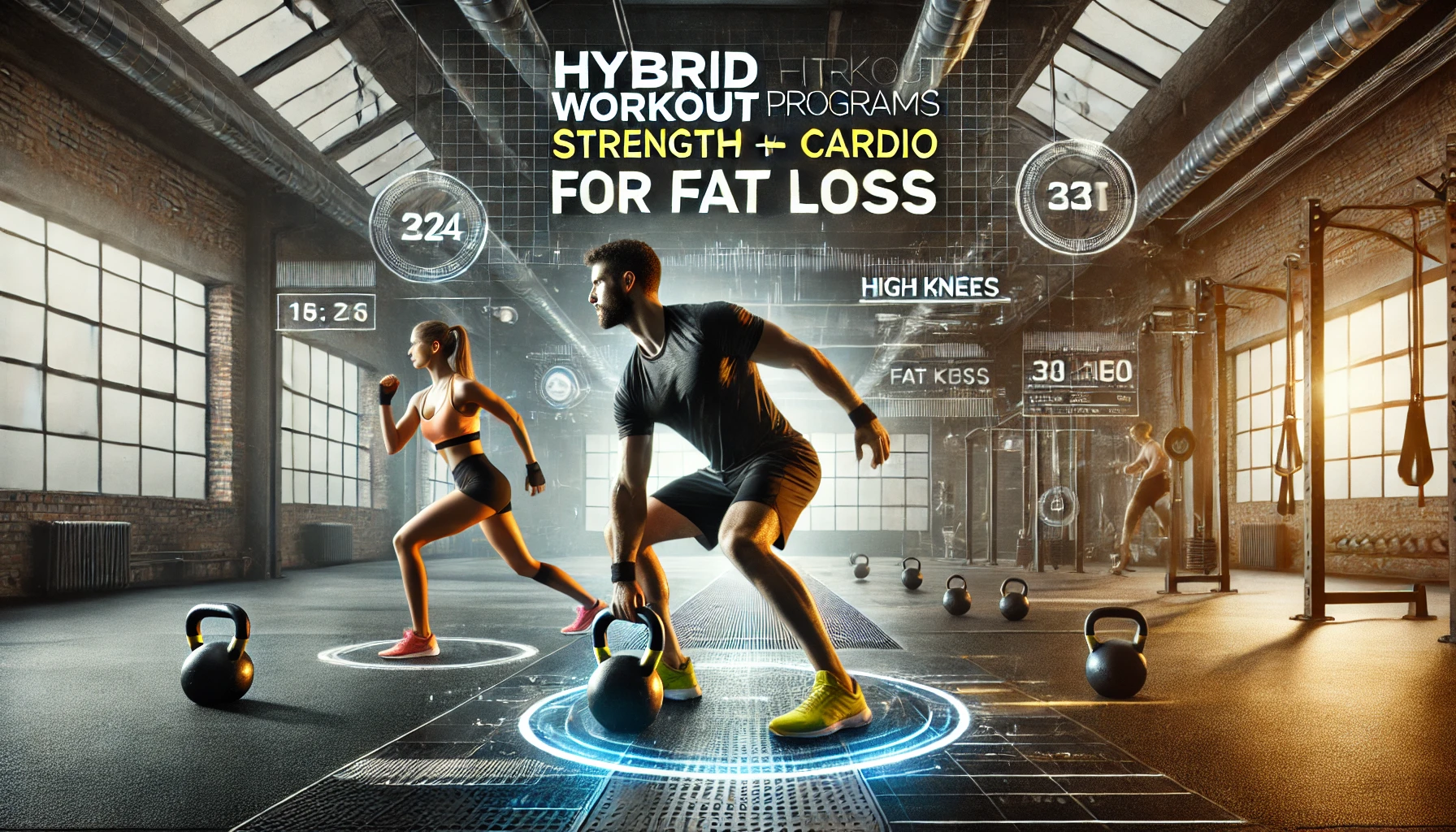Hybrid Workout Programs (Strength + Cardio) for Fat Loss
Did you know that combining strength and cardio in one session can burn up to 30% more calories than doing them separately? That’s the power of hybrid training. It’s not just a trend—it’s a game-changer for fat loss and overall fitness.
Hybrid workout programs are designed to maximize efficiency. Instead of splitting your time between lifting weights and running on the treadmill, you get the best of both worlds in a single session. This approach not only saves time but also keeps your body guessing, which is key for breaking through plateaus.
Think of it like this: you’re at the gym, switching between heavy squats and quick bursts of jumping rope. Your muscles are working hard, and your heart rate stays elevated. The result? Improved body composition, enhanced endurance, and a workout that fits even the busiest schedules.
In this article, we’ll break down how to create a personalized hybrid training plan. Whether you’re a seasoned hybrid athlete or just starting, you’ll find expert-backed tips to help you reach your goals. Let’s get moving!
Understanding the Concept of Hybrid Training
What if you could build muscle and boost endurance in one workout? That’s the essence of hybrid training. It’s a fitness approach that combines strength and cardio to deliver balanced results. Instead of choosing between lifting weights or running, hybrid training lets you do both—efficiently and effectively.
Defining Hybrid Training and Its Core Principles
Hybrid training is about merging two worlds: strength and cardio. The goal is to improve overall fitness without sacrificing one for the other. Its core principles include:
- Specificity: Tailoring workouts to meet your unique goals.
- Progression: Gradually increasing intensity to avoid plateaus.
- Integration: Seamlessly blending strength and cardio exercises.
For example, a session might include heavy squats followed by a quick sprint. This keeps your body challenged and your heart rate elevated.
The Science Behind Blending Strength and Cardio
Research supports the benefits of hybrid training. Studies, like those from Wilson et al., show that combining strength and cardio can enhance both muscle growth and endurance. This dual focus improves overall athletic performance and physical preparedness.
Elite athletes, like Nick Bare, use hybrid training to maintain strength while excelling in endurance sports. This approach challenges the traditional split between strength and cardio, proving that you don’t have to choose one over the other.
Ready to take your fitness to the next level? Check out this hybrid training guide for expert tips and inspiration.
The Benefits of a Hybrid Approach for Fat Loss
Ever wondered why some athletes achieve fat loss faster than others? The answer lies in hybrid training—a method that combines strength and cardio for maximum results. This approach not only burns calories but also keeps your metabolism firing long after the workout ends.

How Combining Disciplines Accelerates Fat Loss
Hybrid training works because it challenges your body in multiple ways. Strength exercises build muscle, which boosts your resting metabolic rate. Cardio, on the other hand, keeps your heart rate elevated, burning calories during the session. Together, they create a powerful fat-burning effect.
Studies show that hybrid workouts can lead to greater fat loss compared to single-modality training. For example, a meta-analysis by Wilson et al. found that participants who combined strength and cardio lost more body fat than those who focused on just one type of exercise.
Here’s why hybrid training is so effective:
- Enhanced Calorie Burn: Combining exercises like burpees and weight lifts keeps your heart rate high, increasing calorie expenditure.
- Metabolic Boost: Building muscle through strength training helps you burn more calories even at rest.
- Time Efficiency: You get the benefits of both strength and cardio in one session, saving time without compromising results.
Hybrid training also helps prevent plateaus by constantly challenging your body. For instance, alternating between heavy squats and sprint intervals keeps your muscles and cardiovascular system engaged.
Balancing rest and work is crucial. Proper recovery ensures you can maintain intensity without burnout. Aim for at least one rest day per week to let your body recover and rebuild.
| Training Type | Fat Loss Impact | Time Efficiency |
|---|---|---|
| Strength Only | Moderate | Low |
| Cardio Only | Moderate | Low |
| Hybrid Training | High | High |
By incorporating hybrid training into your routine, you’ll not only accelerate fat loss but also improve overall health. It’s a win-win for your body and your schedule.
Building Your Customized Hybrid Training Plan
Ready to craft a workout plan that fits your life? A personalized hybrid training plan starts with understanding your current fitness level and setting clear goals. Whether you’re aiming for fat loss, improved endurance, or muscle gain, the right plan can make all the difference.

Assessing Your Fitness Level and Setting Clear Goals
Before diving into a new routine, take a moment to evaluate where you’re starting. Self-assessment tools like fitness apps or a consultation with a trainer can help. Ask yourself: What’s my current strength training ability? How’s my cardio endurance? This baseline will guide your plan.
Next, set realistic goals. Instead of vague targets like “get fit,” aim for specifics like “lose 5 pounds in 8 weeks” or “run a 5K without stopping.” Clear goals keep you motivated and make it easier to track progress.
Designing a Weekly Workout Schedule That Works
Balance is key when creating your weekly plan. Aim for 3-4 days of strength training and 2-3 days of cardio. For example, you could alternate between upper-body strength and running intervals. This approach keeps your body challenged while preventing burnout.
Don’t forget to include recovery days. Rest is just as important as exercise. Schedule at least one full rest day per week and consider active recovery, like yoga or light stretching, on other days.
Tools like MyFitnessPal or Fitbit can help you design and stick to your schedule. Track your progress weekly and adjust as needed. Remember, flexibility is your friend—life happens, and your plan should adapt with it.
Maximizing Results with Hybrid-Workout Sessions
Want to get the most out of your workout time? Balancing high-intensity cardio and resistance training is the key to unlocking superior results. By strategically mixing these elements, you can maximize fat burning, build muscle, and avoid common pitfalls like overtraining.

Strategic Approaches for Mixing Cardio and Strength
One of the best ways to balance cardio and strength is through circuit training. For example, pair heavy squats with 30 seconds of jumping rope. This keeps your heart rate elevated while challenging your muscles. Experts recommend alternating between strength and cardio exercises to maintain intensity and prevent fatigue.
Timing is crucial. Aim for 45-60 minutes per session, with 20-30 minutes dedicated to each component. This ensures you’re giving equal attention to both strength and cardio without overextending yourself.
Preventing Injuries and Overtraining
Proper rest intervals are essential. Take 30-60 seconds between exercises to catch your breath and recover. This reduces the risk of injury and keeps your form intact. As Dr. Price advises, “Adequate recovery is just as important as the workout itself.”
Here are some tips to avoid overtraining:
- Listen to your body: If you’re feeling overly fatigued, take a rest day.
- Fuel properly: Aim for 25-30g of protein post-workout to aid recovery.
- Stick to your plan: A well-structured training plan ensures you’re not overdoing it.
Expert Insights for Effective Sessions
Personal trainers emphasize the importance of variety. “Switching up your routine keeps your body guessing and prevents plateaus,” says fitness coach Sarah Johnson. Incorporate different exercises like burpees, kettlebell swings, and sprints to keep things fresh.
Another thing to consider is your fitness level. Beginners should start with shorter sessions and gradually increase intensity. Advanced athletes can experiment with more complex formats like AMRAP (As Many Rounds As Possible) or EMOM (Every Minute on the Minute).
By balancing high-intensity cardio and resistance training, you’ll see faster results and stay injury-free. It’s all about finding the right mix for your goals and sticking to a plan that works for you.
Key Components: Strength Training and Cardiovascular Workouts
Curious about the best way to combine strength and cardio for a killer workout? The secret lies in balancing foundational moves with strategic cardio intervals. This approach not only builds muscle but also boosts endurance, making it perfect for anyone aiming to gain strength and stamina.

Essential Strength Moves for a Robust Routine
Start with the basics: squats, deadlifts, and bench presses. These exercises are the backbone of any strength routine. Squats target your lower body, deadlifts engage your core and back, and bench presses build upper body power. Together, they create a solid foundation for muscle gain.
For example, adding heavy squats to your routine can increase lower body strength, while bench presses enhance upper body endurance. These moves complement cardio by improving overall power, making it easier to tackle high-intensity intervals later in your workout.
Integrating Cardio Intervals to Boost Endurance
Once you’ve tackled strength training, it’s time to elevate your heart rate with cardio intervals. Sprints, cycling bursts, or even jump rope sessions are great options. These short, intense bursts of activity keep your heart rate high, improving endurance and burning calories.
For example, after a set of deadlifts, try a 30-second sprint. This combination keeps your body challenged and maximizes results in a single hour. Studies show that alternating between strength and cardio can increase calorie burn by up to 30%, making it a time-efficient way to achieve your fitness goals.
If you’re training for a marathon, incorporating these intervals can also improve your running performance. A structured program, guided by a coach, ensures you’re balancing both disciplines effectively.
Remember, the key is to adapt exercises to your fitness level. Whether you’re a beginner or an advanced athlete, finding the right mix of strength and cardio will help you gain both muscle and endurance.
Strategies for Periodization and Progressive Overload
Ever thought about why some athletes keep improving while others hit a wall? The secret lies in periodization and progressive overload. These strategies ensure continuous growth, helping you avoid plateaus and achieve long-term results.

What Is Periodization and Why Does It Matter?
Periodization is the approach of dividing your training into cycles, each with a specific focus. Think of it as a roadmap for your fitness journey. By alternating between phases of intensity and recovery, you keep your body adapting and improving.
For example, a typical cycle might start with a base phase focused on endurance, followed by a strength phase with heavier weights, and finally a competition phase to peak for an event. This structured approach prevents burnout and maximizes performance.
How Progressive Overload Drives Results
Progressive overload is the principle of gradually increasing the demands on your body. Whether it’s adding more weight, increasing reps, or reducing rest time, this method ensures continuous improvement. Small, incremental changes lead to big results over time.
For instance, if you’re lifting weights, adding just 2.5 pounds to your bench press each week can lead to significant strength gains. Similarly, reducing rest intervals between sets can boost endurance and calorie burn.
Structuring Training Cycles for Continuous Improvement
Here’s how to structure your training cycles for optimal performance:
- Base Phase: Focus on general fitness and endurance. This phase minimizes injury risk while building a solid foundation.
- Strength Phase: Increase volume and introduce heavier weights. This phase enhances power and muscle growth.
- Competition Phase: Tailor workouts to mimic event demands. Include race simulations and high-intensity intervals.
- Taper Phase: Reduce volume and intensity to allow recovery and peak performance.
By alternating between these phases, you keep your body challenged and avoid stagnation. Regular evaluation ensures each phase is optimized for your progress.
Benefits for Beginners and Seasoned Athletes
This approach works for everyone. Beginners can start with shorter cycles and lighter weights, gradually increasing intensity. Advanced athletes can experiment with complex formats like AMRAP (As Many Rounds As Possible) or EMOM (Every Minute on the Minute).
For example, a 12-week cycle might include 4 weeks of base training, 4 weeks of strength work, and 4 weeks of competition prep. This structure ensures steady progress and prevents overtraining.
Remember, controlled progression is key to lasting fitness gains. By mastering periodization and progressive overload, you’ll unlock your full potential and achieve your goals.
Tips for Safe Training and Injury Prevention
How can you train hard without risking injury? The answer lies in balancing intensity with smart recovery strategies. Staying safe while pushing your limits is key to long-term health and progress.

The Importance of Rest and Recovery in a Hybrid Plan
Rest isn’t just downtime—it’s where your body rebuilds. Skipping recovery can lead to overuse injuries and burnout. Studies show that proper rest improves heart health and reduces the risk of injuries.
Here’s how to make recovery a priority:
- Schedule rest days: Aim for at least one full rest day per week.
- Active recovery: Try yoga, stretching, or light walks to keep your body moving without strain.
- Listen to your body: If you’re feeling overly sore or fatigued, take a break.
Effective Techniques to Prevent Overuse Injuries
Overuse injuries happen when you push too hard, too fast. Gradual progress is the key to staying injury-free. Start with lighter weights and shorter sessions, then increase intensity over time.
Here are some expert-backed tips:
- Warm up properly: Spend 5-10 minutes on dynamic stretches or light cardio.
- Focus on form: Poor technique can strain muscles and joints. Consider taking a class or working with a trainer to refine your movements.
- Use recovery tools: Foam rolling and massage guns can ease muscle tension and improve flexibility.
“Recovery isn’t optional—it’s essential. Your body needs time to heal and grow stronger.” – Fitness Expert Sarah Johnson
Balancing intense workouts with proper recovery ensures you stay on track without setbacks. By prioritizing your health, you’ll see better results and enjoy the journey.
Tracking Progress and Making Adjustments
How do you know if your hybrid training program is working? Tracking your progress is the key to staying on track and making smart adjustments. Whether you’re lifting heavier weights or running faster, measuring your improvements keeps you motivated and ensures your plan evolves with your goals.

Measuring Performance and Setting Milestones
Start by tracking the basics: weights, reps, and times. For example, if your deadlift has increased by 20 pounds in a month, that’s a clear sign of progress. Apps like MyFitnessPal or Fitbit can help you log these metrics and spot trends over time.
Set specific milestones to celebrate. Maybe you want to run a 5K in under 30 minutes or bench press your body weight. These goals give you something to aim for and make your progress tangible.
Adapting Your Plan for Ongoing Success
Regularly review your performance to identify what’s working and what’s not. If your strength endurance is improving but your cardio feels stagnant, adjust your plan. Add more intervals or try a new cardio modality like cycling or rowing.
Here’s how to keep your training program effective:
- Track consistently: Log every session to see patterns and improvements.
- Celebrate small wins: Even a 5% increase in power is worth noting.
- Adjust as needed: If you’re hitting plateaus, tweak your routine to keep challenging your body.
Remember, progress isn’t always linear. Some weeks you’ll feel unstoppable, while others might feel slower. That’s normal. The key is to stay consistent and make small, smart changes to your hybrid training program.
For more tips on creating a flexible workout plan, check out this hybrid training program guide.
Your Path to Lasting Fitness and Fat Loss Success
Starting a hybrid training program is one of the best ways to transform your fitness journey. By blending strength and cardio, you’ll not only burn fat but also build endurance and muscle. Consistency is key—stick to your plan, track your progress, and celebrate small wins along the way.
Balancing workout volume with proper rest recovery ensures you stay injury-free and energized. Studies show that hybrid training maximizes results by improving both cardio benefits and muscle gain. Whether you’re a beginner or a seasoned athlete, this approach adapts to your goals and lifestyle.
Ready to take the next step? Start by implementing the strategies outlined in this hybrid training plan. Remember, success comes from smart programming and a commitment to progress. Your body and mindset will thank you.
